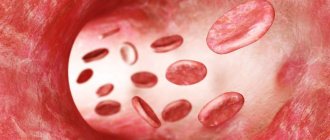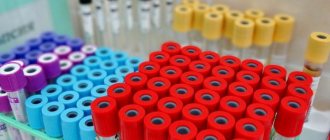Why is analysis needed and what does it give?
| During an annual medical examination, persons over 40 years of age are recommended to undergo a fecal occult blood test. The analysis reveals gastrointestinal pathologies in the early stages, which makes it possible to use it as a screening method. Any inflammation, polyp or tumor of the intestine is accompanied by bleeding, but the amount of blood is so small that it cannot be determined visually. However, this amount is sufficient to determine blood contamination using a laboratory method. |
There are two methods for determining occult blood in stool:
- benzidine (guaiac test)
- shows an admixture of any hemoglobin in the stool. Therefore, the method gives a number of errors in the absence of preparation in the form of a special diet three days before the test;
- immunochemical method
is the most accurate. It shows the presence of human hemoglobin, and not what comes from food. The method does not require special preparation. The disadvantage of the immunochemical method is the long readiness period, about 14 days.
Description
A stool examination aimed at identifying hidden bleeding from parts of the gastrointestinal tract can also be used to screen for colorectal cancer.
Allows you to detect the presence of hemoglobin and haptohemoglobin complex in stool even in cases where visually the color of stool is unchanged, and red blood cells are not detected during microscopic examination of stool. Bleeding from the gastrointestinal tract is one of the common problems faced by practicing physicians of all specialties, but the greatest danger is posed by small “hidden” bleedings that cannot be detected without a special study, and often these small bleedings are markers of including intestinal cancer in apparently healthy people.
The ColonView study is carried out using an immunochemical method, which significantly increases sensitivity, and unlike other tests (gavaiac and benzidine), which is specific exclusively to human hemoglobin, which means it does not require adherence to a strict diet, refusal of meat products, some vegetables and fruits that contain large amounts of ascorbic acid, catalase and peroxidase (for example, cucumbers, cauliflower, use of horseradish seasonings).
When is a referral for analysis issued?
In addition to screening the age group over forty years, the doctor writes a referral for this test in the following cases:
|
The analysis reveals the slightest damage to the walls of the intestine. If an admixture of blood higher than normal is detected in the stool, the test is repeated and, if the result is confirmed, the patient is sent to see a proctologist or gastroenterologist.
Indications for use
- As a preventive examination for persons over 50 years of age.
- Diagnosis of pathology of the digestive tract, accompanied by hidden bleeding: colon polyps, colon diverticula, ulcerative colitis, Crohn's disease.
- Screening for colorectal cancer.
- Infestation by helminths that injure the intestinal wall.
- Rendu-Osler disease with localization of bleeding telangiectasias on the mucous membrane of the gastrointestinal tract.
- Typhoid fever, diagnosis of necrotizing enterocolitis.
- As a differential diagnosis of anemia.
- As a preventive examination for persons over 50 years of age.
- Diagnosis of necrotizing enterocolitis.
Transferrin
Transferrin is a beta globulin (two-component protein) found in blood plasma, the main function of which is to transport iron. It is produced by the liver.
Iron is one of the important microelements necessary to ensure normal functioning of the body. It is the main component of hemoglobin, a complex protein that fills red blood cells and carries oxygen from the lungs to all tissues and organs. In addition, iron is present in myoglobin (the oxygen-binding protein of skeletal muscles and the heart) and a number of enzymes. The normal iron content is 4-5 g, of which 3-4 mg circulates in the blood plasma, which corresponds to approximately 0.1% of the total volume of the microelement.
Iron enters the body with food or is released during the breakdown of red blood cells. Absorption of iron from food occurs in the intestine with its subsequent accumulation in the epithelial cells of the small intestinal mucosa. From here, transferrin transports it to sites of accumulation or use (liver, spleen, reticulocytes and their precursors in the bone marrow). Iron, released from heme when red blood cells are broken down in the liver, bone marrow and spleen, is transported by transferrin to the bone marrow. Some of it combines with ferrittin and hemosiderin. A distinctive characteristic of transferrin is its ability to attach iron in a mass exceeding the mass of transferrin itself.
The saturation of transferrin with iron is about 30-40% of the maximum capacity. This indicator is normal. To determine the degree of saturation of transferrin with iron, determine the total iron-binding capacity of the serum (item 690 in the price list), the unsaturated (latent) iron-binding capacity of the serum, and calculate the percentage of transferrin saturation.
The level of iron and the amount of transferrin synthesized are inversely related: the lower the iron level, the higher the synthesis of transferrin. The amount of transferrin produced depends on the following factors:
- liver performance;
- the body's needs for iron;
- availability of its reserves;
- bowel performance;
- completeness of nutrition.
Transferrin production decreases when functional liver tissue is replaced by scar tissue (typical of cirrhosis). The same result is caused by impaired absorption of amino acids in the inflamed intestine and an insufficient amount of protein food.
2 iron atoms (Fe3+ ions) are bound to one transferrin molecule, and 1.25 mg to 1 g, respectively. Based on this ratio, the amount of iron that can be bound by transferrin contained in the blood serum is calculated. The result obtained is approximately equal to the value of TIC (total iron-binding capacity of serum).
The patient's condition can also be assessed by the ratio of iron levels to the maximum transferrin vital value. This calculated value reflects the percentage of iron saturation of transferrin and should normally be equal to 30%. A lower rate indicates the presence of iron deficiency anemia. This condition occurs when iron levels decrease and transferrin levels increase. If the indicator is significantly higher than normal, this is fraught with the appearance of low molecular weight iron in the plasma. It accumulates in the pancreas and liver, causing their damage.
To determine the concentration of transferrin and the percentage of its saturation with iron, there are two methods: direct - immunometric determination of the concentration, and indirect - measurement of the iron-binding ability of serum by saturating it with excess iron. The first method is more accurate. Transferrin concentrations in men are 10% lower than in women. In the last trimester of pregnancy, the content of this protein can double. As people age, transferrin concentrations decrease. In the presence of inflammation, transferrin acts as a negative acute phase protein - its level decreases.
Hidden blood in feces, quantitatively (FOB Gold method)
An immunological method for the quantitative determination of hemoglobin in stool, which allows the diagnosis of minor occult bleeding from the lower gastrointestinal tract.
Synonyms Russian
Hidden blood in feces (quantitative immunochemical method).
English synonyms
FOB Gold Test, Immunological faecal occult blood test (iFOBT).
Research method
Immunochemical method.
Units
ng/ml (nanograms per milliliter).
What biomaterial can be used for research?
Cal.
How to properly prepare for research?
- Avoid taking laxatives, administering rectal suppositories, oils, limit taking medications that affect intestinal motility (belladonna, pilocarpine, etc.) 72 hours before stool collection.
- The study should be carried out before performing sigmoidoscopy and other diagnostic procedures in the area of the intestines and stomach or at least 2 weeks after such.
General information about the study
Colorectal cancer is one of the most common types of tumors, both in terms of incidence and mortality. It ranks second in mortality among malignant neoplasms in men and women. Every year there are more than 1 million new cases of the disease worldwide, and the annual death rate exceeds 500,000. The risk of developing the disease increases with age, 90% of those affected are over 55 years of age. According to epidemiological data, heredity is the cause of the development of colorectal cancer in 5-30% of patients. Hereditary syndromes that significantly increase your risk of developing it include familial adenomatous polyposis, Lynch syndrome, juvenile polyposis, and some rarer conditions. A patient's 5-year survival rate depends on the stage of the cancer at the time of diagnosis.
Colorectal cancer develops slowly over several years. The tumor often occurs as a result of the transformation of a polyp of the intestinal mucosa. This process can take from 8 to 12 years. Not all types of polyps can turn into tumors, but their presence, especially in large quantities, significantly increases the risk of developing colorectal cancer. Other precancerous conditions include dysplasia, which is typical for people with ulcerative colitis and Crohn's disease.
With colorectal cancer, blood can be released in the stool long before the first symptoms of the disease. Screening examination of feces for occult blood among people at risk helps to diagnose the disease in a timely manner and reduce mortality from colorectal cancer by 15-33%. The effectiveness of such screening has been confirmed by several studies.
To detect hidden blood in stool, guaiac or benzidine tests are most often used, but they require strict adherence to certain rules, in particular following a diet several days before the test. In addition, unlike the guaiac test, modern immunochemical methods are highly sensitive and specific.
The fecal occult blood (FOB) immunoassay test has been proven to be the most convenient test method due to its ease and effectiveness in patient management. It allows you to accurately determine the amount of hemoglobin (Hb) in the stool, without requiring patients to follow a diet or change their lifestyle. The method is based on an antigen-antibody agglutination reaction between the human hemoglobin present in the sample and the anti-hemoglobin antibody on latex particles. Agglutination is measured as an increase at absorbance of 570 nm, the unit of which is proportional to the amount of human hemoglobin in the sample. The study determines hidden blood that has entered the intestinal lumen in the lower parts of the gastrointestinal tract, since hemoglobin from the upper parts is destroyed when passing through the digestive tract.
A positive test result requires further examination to clarify the reasons, since the source of minor blood loss may be a benign polyp, diverticulum, hemorrhoids, or inflammatory bowel disease. On average, 1-5% of people test positive for occult blood, of which 2-10% are diagnosed with cancer, and 20-30% are diagnosed with adenomatous polyps of the colon. If occult blood is positive, further testing is done to look for cancer, a polyp, or another cause of bleeding. To confirm the diagnosis, patients in the absence of contraindications are prescribed colonoscopy, sigmoidoscopy or double contrast radiography. The absence of blood in the stool does not completely exclude the possibility of colorectal cancer, so endoscopy is recommended for people at high risk (with a family history), even if the test result is negative.
What is the research used for?
- For screening for colon and rectal cancer.
- For the diagnosis of bleeding from the lower gastrointestinal tract in certain benign and inflammatory diseases (colon polyps, Crohn's disease, ulcerative colitis, hemorrhoids).
When is the study scheduled?
- During a preventive annual examination of persons aged 50-75 years.
- If you suspect hidden intestinal bleeding.
What do the results mean?
Reference values: 0 - 50 ng/ml.
A positive result indicates minor bleeding from the lower gastrointestinal tract. To clarify the cause of bleeding, endoscopic diagnostic methods (sigmoidoscopy, colonoscopy) are necessary.
Possible reasons for a positive result:
- colon or rectal cancer,
- polyps and adenomas of the large intestine,
- inflammatory diseases of the large intestine (Crohn's disease, ulcerative colitis),
- intestinal diverticulosis,
- haemorrhoids.
A negative result cannot completely exclude the possibility of colorectal cancer.
What can influence the result?
- Damage to the intestinal mucosa during medical procedures (colonoscopy, sigmoidoscopy, enemas) performed several days before the study can lead to false-positive results.
Important Notes
- The sample must be collected from three different areas.
- The study is not recommended to be carried out within two weeks after colonoscopy, sigmoidoscopy, and cleansing enemas.
Also recommended
- CA 72-4
- CA 242
- Tumor Marker 2 (TM 2) – pyruvate kinase
- Carcinoembryonic antigen (CEA)
- Fecal occult blood test
- General laboratory screening (oncological)
- Predisposition to colorectal cancer
Who orders the study?
Gastroenterologist, proctologist, surgeon, therapist, oncologist.
Literature
- European guidelines for quality assurance in colorectal cancer screening and diagnosis: overview and introduction to the full supplement publication. Endoscopy 2013 Jan;45(1):51-9.
- Haug U, Hundt S, Brenner H. Quantitative immunochemical fecal occult blood testing for colorectal adenoma detection: evaluation in the target population of screening and comparison with qualitative tests. Am J Gastroenterol. Mar 2010; 105(3):682-90.
- Levi Z, Rozen P, et al. A quantitative immunochemical fecal occult blood test for colorectal neoplasia. Ann Intern Med. 2007 Feb 20;146(4):244-55.





